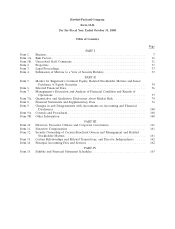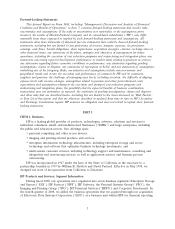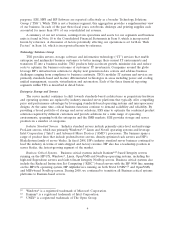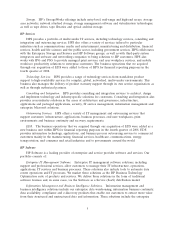HP 2008 Annual Report Download - page 17
Download and view the complete annual report
Please find page 17 of the 2008 HP annual report below. You can navigate through the pages in the report by either clicking on the pages listed below, or by using the keyword search tool below to find specific information within the annual report.Seasonality
General economic conditions have an impact on our business and financial results. From time to
time, the markets in which we sell our products experience weak economic conditions that may
negatively affect sales. We experience some seasonal trends in the sale of our products and services.
For example, European sales often are weaker in the summer months and consumer sales often are
stronger in the fourth calendar quarter. Demand during the spring and early summer months also may
be adversely impacted by market anticipation of seasonal trends. See ‘‘Risk Factors—Our sales cycle
makes planning and inventory management difficult and future financial results less predictable,’’ in
Item 1A, which is incorporated herein by reference.
Competition
We encounter aggressive competition in all areas of our business activity. We compete primarily on
the basis of technology, performance, price, quality, reliability, brand, reputation, distribution, range of
products and services, ease of use of our products, account relationships, customer training, service and
support, security and availability of application software and our Internet infrastructure offerings.
The markets for each of our business segments are characterized by vigorous competition among
major corporations with long-established positions and a large number of new and rapidly growing
firms. Product life cycles are short, and to remain competitive we must develop new products and
services, periodically enhance our existing products and services and compete effectively on the basis of
the factors listed above. In addition, we compete with many of our current and potential partners,
including OEMs that design, manufacture and often market their products under their own brand
names. Our successful management of these competitive partner relationships will continue to be
critical to our future success. Moreover, we anticipate that we will have to continue to adjust prices on
many of our products and services to stay competitive.
On a revenue basis we are the largest U.S.-based company offering our range of general purpose
computers and personal information, imaging and printing products for industrial, scientific, business
and consumer applications, and IT services. We are the leader or among the leaders in each of our
principal business segments.
The competitive environments in which each segment operates are described below:
Enterprise Storage and Servers. The areas in which ESS operates are intensely competitive and are
characterized by rapid and ongoing technological innovation and price reductions. Our competitors
range from broad solution providers such as International Business Machines Corporation (‘‘IBM’’) to
more focused competitors such as EMC Corporation and Network Appliance, Inc. in storage, Dell, Inc.
(‘‘Dell’’) in industry standard servers, and Sun Microsystems, Inc. in both industry standard and
UNIX↧-based servers. We believe that our important competitive advantages in this segment include
the six technology components of our adaptive infrastructure initiatives: IT systems, power and cooling,
security, management, virtualization and automation. We believe that our competitive advantages also
include our global reach and our significant intellectual property portfolio and research and
development capabilities, which will contribute to further enhancements of our product and service
offerings and our ability to cross-sell our portfolio and leverage scale advantages in everything from
brand to procurement leverage.
HP Services. Our service businesses, including EDS, compete in IT support services, consulting
and integration, infrastructure technology outsourcing, business process outsourcing and application
services. The IT support services and consulting and integration markets have been under significant
pressure as our customers have reduced their IT budgets. However, this trend has benefited the
outsourcing services business as customers drive toward lower IT management costs to enable more
strategic investments. Our competitors include IBM Global Services, Computer Sciences Corporation,
11
























